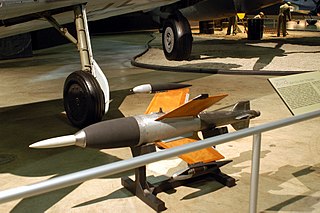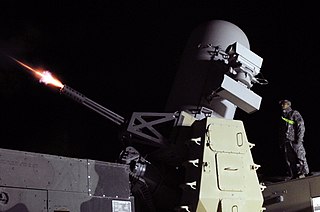Related Research Articles

The Enzian was a German WWII surface-to-air anti-aircraft missile that was the first to use a radio controlled guidance system. During the missile's development in the late stages of the war it was plagued by organisational problems and was cancelled before becoming operational.

A surface-to-air missile (SAM), also known as a ground-to-air missile (GTAM) or surface-to-air guided weapon (SAGW), is a missile designed to be launched from the ground to destroy aircraft or other missiles. It is one type of anti-aircraft system; in modern armed forces, missiles have replaced most other forms of dedicated anti-aircraft weapons, with anti-aircraft guns pushed into specialized roles.

Fritz X was the most common name for a German guided anti-ship glide bomb used during World War II. Fritz X was the world's first precision guided weapon deployed in combat and the first to sink a ship in combat. Fritz X was a nickname used both by Allied and Luftwaffe personnel. Alternative names include Ruhrstahl SD 1400 X, Kramer X-1, PC 1400X or FX 1400.

The Henschel Hs 293 was a World War II German radio-guided glide bomb. It is the first operational anti-shipping missile, first used unsuccessfully on 25 August 1943 and then with increasing success over the next year, ultimately damaging or sinking at least 25 ships. Allied efforts to jam the radio control link were increasingly successful despite German efforts to counter them. The weapon remained in use through 1944 when it was also used as an air-to-ground weapon to attack bridges to prevent the Allied breakout after D-Day, but proved almost useless in this role.

Rheintochter was a German surface-to-air missile developed by Rheinmetall-Borsig during World War II. Its name comes from the mythical Rheintöchter (Rhinemaidens) of Richard Wagner's opera series Der Ring des Nibelungen.
Rheinbote was a German short range ballistic rocket developed by Rheinmetall-Borsig at Berlin-Marienfelde during World War II. It was intended to replace, or at least supplement, large-bore artillery by providing fire support at long ranges in an easily transportable form.

The Wasserfall Ferngelenkte FlaRakete was a German guided supersonic surface-to-air missile project of World War II. Development was not completed before the end of the war and it was not used operationally.

The Henschel Hs 117 Schmetterling was a radio-guided German surface-to-air missile project developed during World War II. There was also an air-to-air version, the Hs 117H.

The Ruhrstahl Ru 344 X-4 or Ruhrstahl-Kramer RK 344 was a wire-guided air-to-air missile designed by Germany during World War II. The X-4 did not see operational service and thus was not proven in combat but inspired considerable post-war work around the world, and was the basis for the development of several ground-launched anti-tank missiles.

Fireflash was the United Kingdom's first air-to-air guided missile to see service with the Royal Air Force. Constructed by Fairey Aviation, the missile utilised radar beam riding guidance. Fireflash had relatively limited performance and required the launching aircraft to approach the target from a limited angle astern.

Wunderwaffe is a German word meaning "wonder-weapon" and was a term assigned during World War II by Nazi Germany's propaganda ministry to some revolutionary "superweapons". Most of these weapons however remained prototypes, which either never reached the combat theater, or if they did, were too late or in too insignificant numbers to have a military effect. The V-weapons, which were developed earlier and saw considerable deployment, especially against London and Antwerp, trace back to the same pool of highly inventive armament concepts. In the German language, the term Wunderwaffe generally refers to a universal solution which solves all problems related to a particular issue, mostly used ironically for its illusionary nature.

The Henschel Hs 294 was a guided air-to-sea missile developed by Henschel Flugzeug-Werke in Germany during World War II.

Operation Bumblebee was a US Navy effort to develop surface-to-air missiles (SAMs) to provide a mid-range layer of anti-aircraft defense between anti-aircraft guns in the short range and fighter aircraft operating at long range. A major reason for the Bumblebee efforts was the need to engage bombers before they could launch standoff anti-shipping weapons, as these aircraft might never enter the range of the shipboard guns.

Taifun was a German World War II anti-aircraft unguided rocket system. Waves of small, relatively cheap, Taifun flak rockets were to be launched en masse into Allied bomber formations. Although never deployed operationally, the Taifun was further developed in the US as the 76mm HEAA T220 "Loki" Rocket.

The Rocket Propulsion Establishment at Westcott, Buckinghamshire on the site of the former RAF Westcott has made a number of notable contributions in the field of rocket propulsion, including input on the rocket design for the Blue Streak missile and the propulsion systems on Chevaline. It was also known as the Guided Projectiles Establishment and PERME Westcott.

Counter rocket, artillery, and mortar, abbreviated C-RAM or counter-RAM, is a set of systems used to detect and/or destroy incoming rockets, artillery, and mortar rounds in the air before they hit their ground targets, or simply provide early warning.

The Henschel Hs 298 was a 1940s German rocket-powered air-to-air missile designed by Professor Herbert Wagner of Henschel.

Feuerlilie was the code name of a German anti-aircraft missile, which was developed in 1940 and was shelved because of problems with the controller and the drive section at the end of January 1945 in favour of other projects. The Feuerlilie was built and tested at Rheinmetall-Borsig in two versions: the F-25 with a diameter of 25 cm, and the larger F-55 55 cm in diameter. The engines were Rheinmetall 109-505/515 solid rockets.
Funryu were a series of surface-to-air anti-aircraft missiles developed in Japan at the end of the Second World War. The missile's development in the late stages of the war was plagued by organizational problems and cancelled before becoming operational.
References
- ↑ Fiesler Fi103 (V1) - Royal Air Force Museum, Cosford (UK) Archived 2004-01-30 at the Wayback Machine
- ↑ V2 (Assembly 4) - Royal Air Force Museum, Cosford (UK)
- ↑ Rheinmetall Borsig Rheinbote - Royal Air Force Museum, Cosford (UK)
- ↑ Holzbrau-Kissing Enzian (Gentian Violet) - Royal Air Force Museum, Cosford (UK) Archived 2004-01-30 at the Wayback Machine ; Fitzsimons, Bernard, ed. The Illustrated Encyclopedia of 20th Century Weapons and Warfare (London: Phoebus, 1978), Volume 8, p.849, "Enzian".
- ↑ Fitzsimons, Volume 20, p.2212, "Rheintochter".
- ↑ Rheinmetall Borsig Rheintochter (Daughter of the Rhein) R1 - Royal Air Force Museum, Cosford (UK)
- ↑ Henschel Hs117 Schmettering (Butterfly) - Royal Air Force Museum, Cosford (UK) Archived 2004-01-30 at the Wayback Machine
- ↑ EMW C2 Wasserfall
- ↑ Feuerlilie (Fire Lily) - Royal Air Force Museum, Cosford (UK) Archived 2004-01-30 at the Wayback Machine
- ↑ Fitzsimons, Bernard, general editor. The Encyclopedia of 20th Century Weapons and Warfare (London: Phoebus Publishing Company, 1978), Volume 24, pp. 2602-2603, "X-4, Ruhrstahl".
- ↑ Fitzsimons, p. 2603, "X-7, Ruhrstahl".